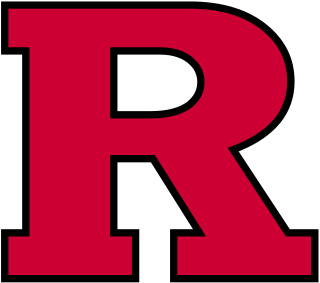
College football is gridiron football consisting of American football played by teams of student athletes fielded by American universities, colleges, and military academies, or Canadian football played by teams of student athletes fielded by Canadian universities. It was through college football play that American football rules first gained popularity in the United States.

The end zone is the scoring area on the field, according to gridiron-based codes of football. It is the area between the end line and goal line bounded by the sidelines. There are two end zones, each being on an opposite side of the field. It is bordered on all sides by a white line indicating its beginning and end points, with orange, square pylons placed at each of the four corners as a visual aid. Canadian rule books use the terms goal area and dead line instead of end zone and end line respectively, but the latter terms are the more common in colloquial Canadian English. Unlike sports like association football and ice hockey which require the ball/puck to pass completely over the goal line to count as a score, both Canadian and American football merely need any part of the ball to break the vertical plane of the outer edge of the goal line.

Gridiron football, also known as North American football or, in North America, simply football, is a family of football team sports primarily played in the United States and Canada. American football, which uses 11-player teams, is the form played in the United States and the best known form of gridiron football worldwide, while Canadian football, featuring 12-player teams, predominates in Canada. Other derivative varieties include indoor football and Arena football, football for smaller teams, and informal games such as touch and flag football. Football is played at professional, collegiate, high school, semi-professional, and amateur levels.

Placekicker, or simply kicker, is the player in gridiron football who is responsible for the kicking duties of field goals and extra points. In many cases, the placekicker also serves as the team's kickoff specialist or punter as well.
Nine-a-side football is a sport based on Australian rules football played informally by Aussie rules clubs but not yet an official sport in its own right.

The Rutgers Scarlet Knights football team represents Rutgers University in the Football Bowl Subdivision (FBS) of the National Collegiate Athletics Association (NCAA). Rutgers competes as a member of the East Division of the Big Ten Conference. Prior to joining the Big Ten, the team was a member of the American Athletic Conference from 1991 to 2013. Rutgers plays its home games at SHI Stadium, in Piscataway, New Jersey. The team is led by head coach Greg Schiano. The Rutgers Scarlet Knights football team is notable for playing in the first ever intercollegiate football game in 1869, in which they defeated Princeton University by a score of 6–4. For this reason, Rutgers has been described as "the birthplace of college football."

The Rutgers Scarlet Knights are the athletic teams that represent Rutgers University's New Brunswick campus. In sports, Rutgers is famously known for being the "Birthplace of College Football", hosting the first ever intercollegiate football game on November 6, 1869 in which Rutgers defeated a team from the College of New Jersey with a score of 6 runs to 4.

The 1892 Alabama Cadets football team represented the University of Alabama in the 1892 college football season. The team was led by their head coach E. B. Beaumont and played their home games at Lakeview Park in Birmingham, Alabama. In what was the inaugural season of Alabama football, the team finished with a record of two wins and two losses (2–2).

American football, referred to simply as football in the United States and Canada and also known as gridiron, is a team sport played by two teams of eleven players on a rectangular field with goalposts at each end. The offense, the team with possession of the oval-shaped football, attempts to advance down the field by running with the ball or passing it, while the defense, the team without possession of the ball, aims to stop the offense's advance and to take control of the ball for themselves. The offense must advance at least ten yards in four downs or plays; if they fail, they turn over the football to the defense, but if they succeed, they are given a new set of four downs to continue the drive. Points are scored primarily by advancing the ball into the opposing team's end zone for a touchdown or kicking the ball through the opponent's goalposts for a field goal. The team with the most points at the end of a game wins.
The 1869 college football season was the first season of intercollegiate football in the United States. While played using improvised rules more closely resembling soccer and rugby than modern gridiron football, it is traditionally considered the inaugural college football season. The 1869 season consisted of only two games, both between Rutgers and Princeton. The first was played on November 6 at Rutgers' campus, and the second was played on November 13 at Princeton's campus. Both games were won by the home team.
The 1870 college football season is regarded as the second United States intercollegiate football season. The season involved only three teams and two known games which took place in November 1870. As in 1869, the season's two games occurred about fifteen miles apart in New Brunswick and in Princeton, New Jersey.

Football is a family of team sports that involve, to varying degrees, kicking a ball to score a goal. Unqualified, the word football normally means the form of football that is the most popular where the word is used. Sports commonly called football include association football ; gridiron football ; Australian rules football; rugby football ; and Gaelic football. These various forms of football share to varying extent common origins and are known as football codes.

Circle rules football, commonly referred to as circle rules, is a team sport played between two teams of six with a large spherical ball similar to a stability ball. Invented in New York City in 2006, the sport is currently played in cities across the United States, as well as in several international locations.
The Rutgers Scarlet Knights men's soccer team is a varsity intercollegiate athletic team of Rutgers University–New Brunswick in New Brunswick, New Jersey, United States. The team is a member of the Big Ten Conference, which is part of the National Collegiate Athletic Association's Division I. Rutgers's first varsity's men's soccer team was fielded in 1938, although organized soccer has been played at the university since at least 1869. The team plays its home games at Yurcak Field in New Brunswick. The Knights are coached by Jim McElderry.

The 1879 Navy Midshipmen football team represented the United States Naval Academy in the 1879 college football season. The team was the first intercollegiate football squad to represent the United States Naval Academy. The team had no coach, as it was entirely student-operated; however, it was captained by squad member Bill Maxwell. The team played just a single game, which was a scoreless tie with the Baltimore Athletic Club. The team was entirely student operated, and was not supported by the Naval Academy's faculty. The school would not have another football squad until 1882.
The 1882 Navy Midshipmen football team represented the United States Naval Academy in the 1882 college football season. The team was the second intercollegiate football squad to represent the United States Naval Academy, and the first since 1879. The team was coached by player-coach Vaulx Carter, and was entirely student-operated. It was captained by squad member Alex Jackson. The team played just a single game, an 8 to 0 (8–0) shutout of Johns Hopkins, which was the school's first ever win. The squad was entirely student operated, and was not supported by the Naval Academy's faculty. The season would mark the beginning of eight season rivalry between the Midshipmen and Johns Hopkins.
The 1869 Rutgers Queensmen football team represented Rutgers University in the 1869 college football season. The team finished with a 1–1 record and was retroactively named the co-national champion by Parke H. Davis. They played Princeton two times, splitting the series one game apiece. The team had no coach, and its captain was William Leggett.

The early history of American football can be traced to early versions of rugby football and association football. Both games have their origin in varieties of football played in Britain in the mid–19th century, in which a football is kicked at a goal or run over a line, which in turn were based on the varieties of English public school football games.

The Princeton–Rutgers rivalry is a college rivalry in athletics between the Tigers of Princeton University and Scarlet Knights of Rutgers University – New Brunswick, both of which are located in New Jersey. The rivalry dates back to the first college football game in history in 1869. Although the football series ended in 1980 due to the two schools going in different directions with their football programs, the rivalry has continued in other sports, primarily in men's basketball.
Willie Foster is a former gridiron football wide receiver. He played college football for Rutgers, then played for the Winnipeg Blue Bombers of the Canadian Football League (CFL) in 2007.













